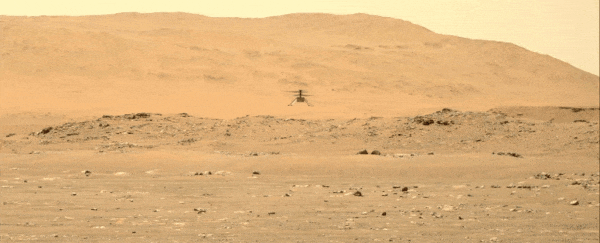NASA's Ingenuity helicopter successfully executed a second, more daring flight over the surface of Mars on Thursday morning.
Ingenuity made its aerial debut with a 3 meter (10 foot) hover on Monday – the first controlled, powered flight ever conducted on another planet. The helicopter flew higher and further on Thursday morning, completing its first sideways movement.
Ingenuity's rotor blades began to spin furiously at 5:33 am ET, when the Sun was high on Mars. As the rotors reached a speed 5 times faster than an Earth helicopter, they gave the chopper enough traction in the thin Martian atmosphere to lift about 5 meters (16 feet) off the ground.
Then Ingenuity tilted itself just 5 degrees, enough for the rotors' thrust to push it sideways for about 2 meters (7 feet) before stopping to hover. From there, it rotated to point its camera in different directions, probably producing stunning color photos that will soon beam back to NASA.
The Perseverance rover, which carried Ingenuity to Mars, should beam back video of the flight as well.
Finally, Ingenuity flew back the way it came and landed gently in the copper-colored Martian dust.
The data that Ingenuity has beamed back to NASA so far "tell us that the flight met expectations and our prior computer modeling has been accurate," Bob Balaram, Ingenuity's chief engineer, said in a NASA press release.
"We have two flights of Mars under our belts," he added, "which means that there is still a lot to learn during this month of Ingenuity."
Go big or go home! The #MarsHelicopter successfully completed its 2nd flight, capturing this image with its black-and-white navigation camera. It also reached new milestones of a higher altitude, a longer hover and lateral flying. pic.twitter.com/F3lwcV9kH2
— NASA JPL (@NASAJPL) April 22, 2021
The data "looks good on altitude, lateral motion, all the turns and landing," Bobby Braun, director of planetary science at NASA's Jet Propulsion Laboratory, said on Twitter. "Another great flight."
Ingenuity's next 3 flights will push it 'to the limit'
Ingenuity's flights offer just a peek at the potential of future space helicopters, which could explore parts of Mars and other planets that are inaccessible to rovers. Caves, canyons, mountains, and rocky terrains could all be the domain of a new generation of space-drone explorers.
The Ingenuity team will probably try to fly again within a few days. They have less than two weeks to complete up to three more increasingly daring aerial escapades. By the final flights, Ingenuity's controllers plan to push the helicopter as far and fast as it will go. In the process, they expect Ingenuity will crash.
"We really want to push the rotorcraft flights to the limit and really learn and get information back from that," MiMi Aung, the project manager for Ingenuity, said in a Monday press briefing.
 An animation shows how Ingenuity flies laterally. (NASA/JPL-Caltech)
An animation shows how Ingenuity flies laterally. (NASA/JPL-Caltech)
"That information is extremely important," she added. "This is a pathfinder. This is about, you know, finding if there any 'unknown unknowns' that we can't model. And we really want to know what the limits are. So we will be pushing the limits, very deliberately."
Aung doesn't expect Ingenuity to land safely on its fifth flight, when she hopes to send it out over 609.60 meters of Martian ground.
"If we do have a bad landing, that will be the end of mission," she said in a briefing before the first flight. "The lifetime will be determined by how well it lands, pretty much."
This article was originally published by Business Insider.
More from Business Insider:
